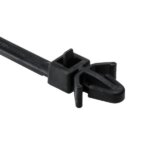Are you unsure whether to choose push-mount cable ties with wings or without? We've got you covered. In this comprehensive guide, we'll explore the differences between the two options and help you make an informed decision.
Understanding Push-Mount Cable Ties
Push-mount cable ties are versatile fastening solutions commonly used for organizing and securing cables and wires. They feature a unique design that allows them to be easily pushed into mounting holes or slots, providing a secure attachment without the need for additional hardware. However, when it comes to push-mount cable ties, you have the option to choose between those with wings and those without. But what's the difference, and which option is best for your needs? Let's find out.
Push-Mount Cable Ties: With Wings
Push-mount cable ties with wings feature extended tabs or wings on one side of the tie. These wings provide additional stability and support when inserting the tie into mounting holes, ensuring a secure attachment. The wings also help prevent the tie from rotating or shifting once installed, providing added reliability in high-vibration environments. Additionally, the wings may offer a larger surface area for labeling or identification purposes, making them ideal for applications where labeling is required.
Push-Mount Cable Ties: Without Wings
On the other hand, push-mount cable ties without wings have a streamlined design without any extended tabs or wings. While they may not offer the same level of stability as ties with wings, they still provide a secure attachment when properly installed. These ties are often preferred for applications where space is limited or where a sleeker, more discreet appearance is desired. Without the wings, these ties may also be easier to insert into tight spaces or crowded panels, making them suitable for compact installations.
Making the Right Choice
When deciding between push-mount cable ties with wings or without, consider your specific application requirements and preferences. If stability and support are paramount, especially in high-vibration environments, opt for ties with wings. On the other hand, if space is limited or you prefer a more streamlined design, ties without wings may be the better choice. Ultimately, both options offer reliable fastening solutions for cable management tasks, so choose the one that best suits your needs.
Scenarios for Using Push-Mount Cable Ties with Wings
1. High-Vibration Environments

In environments prone to vibrations, such as industrial settings or automotive applications, push-mount cable ties with wings provide an essential solution. The additional stability offered by the wings ensures that the ties remain firmly in place, minimizing the risk of loosening or detachment due to constant movement or shaking.
2. Large Cable Bundles
When securing large bundles of cables or wires, it's crucial to have adequate support to prevent sagging or strain. Push-mount cable ties with wings offer better support for these substantial cable bundles. The wings distribute the weight more evenly across the tie, reducing the likelihood of overloading and ensuring a secure attachment.
3. Labeling Requirements
In applications where labeling or identification is necessary, push-mount cable ties with wings are the preferred choice. The extended surface area provided by the wings offers ample space for labeling information, such as cable identification numbers or routing instructions. This allows for easy identification and organization of cables, enhancing overall efficiency and maintenance.
4. Enhanced Security
Security is paramount when it comes to cable management, especially in critical infrastructure or sensitive installations. Push-mount cable ties with wings provide enhanced security by preventing the ties from rotating or shifting once installed securely. The wings act as anchors, keeping the ties firmly in place and minimizing the risk of tampering or unauthorized access.
5. Complex Mounting Configurations
In applications with complex mounting configurations, such as panel assemblies or equipment enclosures, push-mount ties with wings offer a more secure and stable attachment. The wings provide additional points of contact, allowing for a more even distribution of force and reducing the strain on individual mounting points. This ensures that the ties remain securely fastened, even in challenging environments.
6. Limited Space
In installations where space is limited, such as cramped control panels or compact electronic devices, push-moun ties without wings offer a more practical solution. Without the added bulk of wings, these ties can be easily inserted into tight spaces and provide a secure attachment without obstructing surrounding components.
7. Discreet Installations
For applications where aesthetics are important or where a sleek and minimalistic design is desired, push-mount ties without wings are the preferred choice. The absence of wings results in a more discreet appearance, allowing the ties to blend seamlessly into their surroundings without drawing unnecessary attention.
8. Tight Spaces
When working in confined or hard-to-reach spaces, such as behind equipment or within machinery, push-mount cable ties without wings offer greater maneuverability and ease of installation. The streamlined design allows for easier insertion and positioning, even in the most challenging environments, ensuring a secure and reliable attachment.
9. Quick Installations
In scenarios where time is of the essence, such as assembly line production or rapid deployment projects, push-mount ties without wings offer a faster and more efficient installation process. Without the additional steps required for positioning wings, these ties can be quickly inserted and secured, minimizing downtime and maximizing productivity.
10. Streamlined Applications
For applications that prioritize a streamlined and space-saving design, such as consumer electronics or compact machinery, push-mount ties without wings are the ideal choice. Their sleek profile and minimalistic appearance complement the overall aesthetics of the equipment, providing a clean and professional finish.
Wrapping Up
In conclusion, whether you choose push-mount ties with wings or without depends on your specific application requirements and preferences. Both options offer reliable fastening solutions for organizing and securing cables and wires. Now that you understand the differences between the two, you can make an informed decision based on your needs. Ready to explore more cable management tips and solutions? Check out our latest blog post for additional insights!

